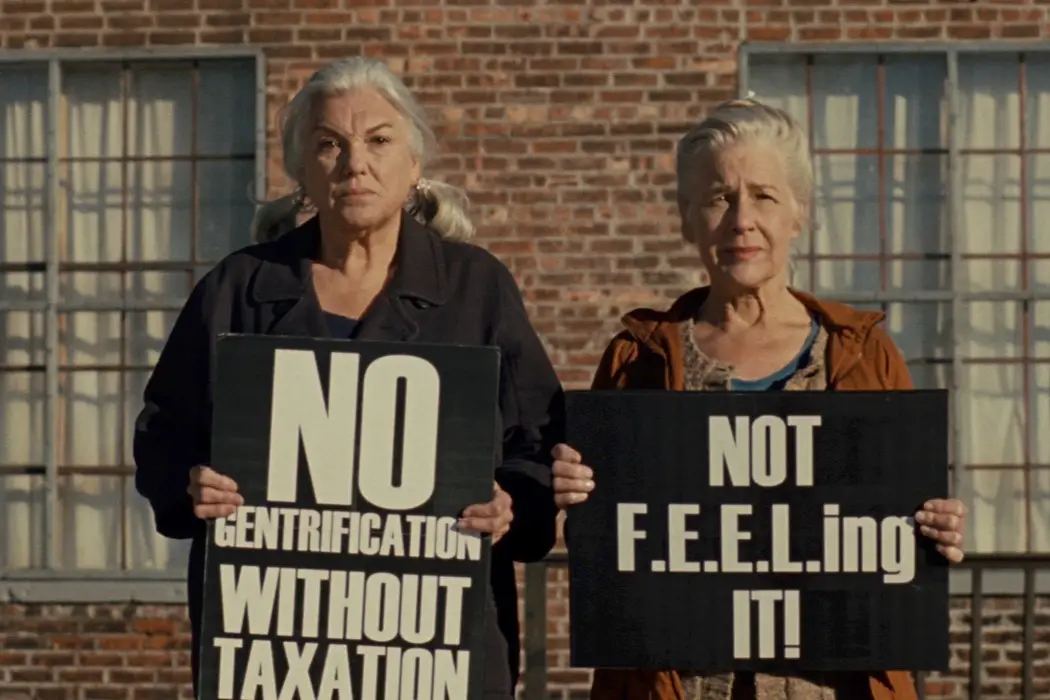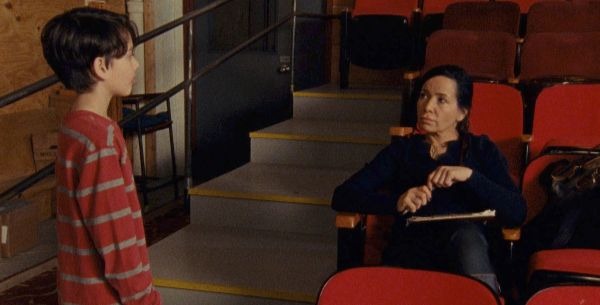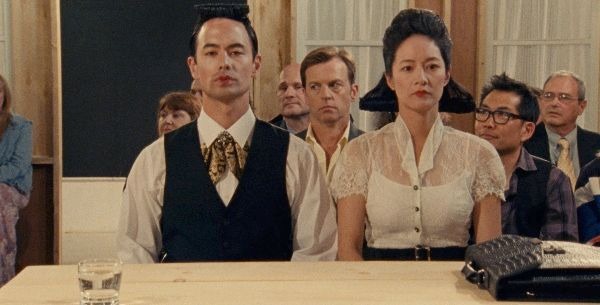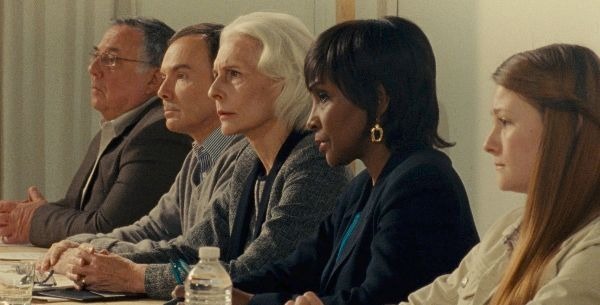A BREAD FACTORY, PART ONE: A Communal Exploration Of Why We Need The Arts

Tynan loves nagging all his friends to watch classic movies…
NOTE: A Bread Factory, Part One is the first installment in Patrick Wang’s 4-hour film project. Although it functions as a standalone film, it is also greatly enhanced seen in conjunction with Part Two.
I have no prior history with Patrick Wang but film types are often afflicted with the need to put writers, directors, and anyone else they possibly can in the context of everyone who ever came before. It’s how we try and make sense of the cinematic landscape (and all that is unfamiliar) by, in an often arbitrary and flawed way, bringing it back to what we already know.
The life-changing films blow up our accepted paradigms; the good ones have elements of movies we’ve enjoyed in the past while still venturing into original territory. Bread Factory fits into this latter category. There is an Altman-esque sense to the tale — a wide-ranging, overlapping and seemingly free-flowing ensemble (with a bevy of speaking roles), held together with an underlying sense of unity and a perceptive eye. Though a combined 4 hours in length, Wang shot all the footage in 24 days total. It’s an efficiency movies only knew in the old days.
Other predecessors that seem easy to toss around include Rainer Werner Fassbinder. Wang has similar roots in the theater and so there is this integration of the facades and two-dimensional space of the theater with film like some of the German director’s earliest work. Fassbinder also ventured into miniseries which at a time before web series and online content, functioned outside the normal context of typical film and television.
We can also mention the likes of Ingmar Bergman, not simply the fact Wang anchors his movie with strong female characters but a project like Scenes From a Marriage ambitiously uses its running time to meticulously examine relationships. Parallels can also be drawn to Jacques Rivette who famously crafted a magnum opus in Out 1 that sprawls out at a behemoth length of over 12 hours!
In comparison, Wang‘s picture is almost insignificant in length but in this current generation of films playing, I’m not sure if we’ve seen much like it. The only thing I can remember trying for anything like this was the relatively forgotten The Disappearance of Eleanor Rigby.
However, for some these names might be meaningless and if that’s the case, there’s no need to fret because we have the film itself. What the time does allow for is a greater exploration of characters and as that is what Wang seems to care most deeply about, it is a worthwhile investment. Again, we have this intersection of the stage and the medium of film. The long takes lend the needed continuity for this to be true as they bleed into each other. We are allowed to watch performances run their course in full with an underlying intimate theatricality.
The Story of A Bread Factory
I will say even with its plain exterior, A Bread Factory ventures into hitherto uncharted territories in some matters and it left me unsure and even a bit flabbergasted during certain interludes. I haven’t seen anything like this on a microscale even if the big picture looks familiar.
This is a story of intimate America. This is Checkford, NY. Where the arts and a community collide in a multi-faceted, unwieldy ecosystem known as The Bread Factory. For well nigh 40 years it has been run by Dorothea (Tyne Daly) and Greta (Elisabeth Henry-Macari) who double as director and actress in their local productions.

The events they offer necessitate the involvement of a wide-ranging ensemble. An acerbic director (Janeane Garofalo) who has a chip on her shoulder, tears people apart in a Q&A while telling little kids they’re wrong right to their faces. But she also manages to be a well of wisdom as strange as that might sound. In her symposium, they learn that the next time they pick up a camera, they need to care about it — even cry about it — and she hammers home “mud” is not a color on any filmmaker’s palette. She, in turn, is flummoxed by Simon (Keaton Nigel Cooke) the young cinephile who runs the in-house projector with far more acumen than most adults. His youthful perceptiveness is a sign of why this institution matters.
Meanwhile, the crotchety Shakespearian actor, Sir Walter (Brian Murray), often finds himself wandering around town, no doubt symptoms of onsetting Alzheimer’s. But one thing he does not forget is his ongoing feud with the eloquent critic Jean-Marc (Philip Kerr), who dared give him a withering review 40 years prior.
The main antagonistic force in this story is May Ray — avant-garde art imports from China — backed by high-powered lawyers and one can only gather some top-tier American conglomerate. They are going to great lengths to push out their local competition. It’s capitalism at its finest.
With the school arts budget now in danger of being cut, one cannot help but recall some of the best Parks and Recreation episodes (particularly the episode “Bailout”) where small-town politics take hold and instigate decisions with wide-ranging consequences. It simultaneously calls to mind the deeply personal lobbying found in the Dardenne Brothers‘ Two Days, One Night.
One important entity for maintaining veracity in all things is the local press. In this regard, we are introduced to Max (Zachary Sayle), a local teen, who’s aspiring to be a journalist even as he’s swept up by this engaging new fad and simultaneously smitten with love. He learns from his editor Jan (Glynnis O’Connor) what the business is really meant to be about. She admonishes him that facts are key but more importantly, she cultivates his raw talents. Someday he will be a fine newsman.
These sprawling vignettes give way to beautiful bits of advice, inspiration, and humor that feels as organic as you might possibly see. We constantly fade in and out between these condensed closeups on life. We learn faces and names and relations to other people over time and through extended interactions and dialogues together. In fact, Wang seems perfectly at home with conversation functioning as extended monologues. It makes sense given his history (he spent his formative years in theater companies) and his obvious affection for the format are altogether evident.
Will Everyone Be Receptive to This Movie?
However, I fear A Bread Factory may not strike the same chord with mainstream audiences. Whereas those surrounded by movies (or theater) often make a habit of taking in all sorts of things, if they find something so singular and different it’s immediately novel; they want to champion it. But there is just enough idiosyncratic about this one, mundane, and slow-moving, it might be dismissed quite easily by some folks if their patience gives out on them. Because they don’t want to see something projected onscreen to remind them of their next door neighbors or the headaches in their own life with family. This is much of what this film will give you, albeit done with a deftly observant touch.
Ironically, it’s exactly one of the pieces of art it’s looking to defend and bring to everyone – not just elites or critics or people who are supposed to have a nose for culture. You don’t need to know who Howard Hawks is, but if you like Cary Grant, then you can still enjoy the heck out of one of their movies.

Or maybe you have no idea about the tragedy of Euripides‘ Hecuba but you can do your best to get something out of it. Even giggling during a monologue in a Chekhov play is welcome as a veteran actress’ makeshift samovar helmet comes tumbling to the floor. Whether it’s purposeful or not, the moment is funny and responding in the most natural way is second nature. In this theater, it is heartily allowed because art should be an open forum — no snobbish standards or dismissal of other’s tastes. The best things that come out of it anyway are the communal, the emotional, and touches of levity we can all enjoy together.
In this world of fast-paced slice and dice editing, I am often a fan of the bygone tradition of long takes. Of course, what this does is slow down the action. It forces us to take heed of everything going on in front of us. Many self-assured films do so for the sake of composition because you can appreciate more.
A Bread Factory uses the uninterrupted time in scene after scene in order to allow more to happen. It prolongs moments to the edges of what is comfortable, at times, but it’s on these fringes where we get little tidbits that normally might be cut out. For other stories, these bits of observation might seem superfluous but in this one, we discover its very bread and butter.
The Final Stand
In one final school board meeting, there is a last desperate push to maintain the funding May Ray looks all but destined to snatch away. One of the defining moments is a fine piece of elocution from Jean-Marc. After a Chinese cultural expect is brought on, equating May Ray to a near religious experience, The Bread Factory’s defender reproaches the opposition for “redefining expertise by the sureness of his opinion rather than anything founded on learning.”

The old man goes on to assert, “we live in an age of crumbs.” The Bread Factory is one of the last bastions of culture for the people. There’s no flashy showmanship or gimmicky spectacles. It trusts that real art even in its most unembellished forms might speak to people.
I think this unpolished quality is what is oftentimes so attractive. We’re so used to popularity contests and artificiality. To have something stripped down and honest is surprisingly in demand, whether it be in art or in life. Because art is never about certainty. It is about a desire to discover more and be ambushed by ideas and culture you never knew before. Life is much the same. Humility and openness is a key. So maybe there is still hope for all of us.
The next slot in the program is allocated to Sir Walter who absent-mindedly shuffles to the front. Turning, he looks contemptuously at the beefcake Hollywood star before him, repping May Ray, only to bluntly proclaim in utter disdain, “That is NOT an Actor!” We expect more of an exchange, especially in the wake of so many plaintive arguments back and forth, but there is no need. It’s the perfect punchline and highlights the picture at its very best, cycling back and forth between heartfelt sincerity and unwitting humor.
What role do you think arts play in our modern culture? Do they have a different place now then they used to?
A Bread Factory Part One and Two were released in the U.S. on October 26th, 2018.
Does content like this matter to you?
Become a Member and support film journalism. Unlock access to all of Film Inquiry`s great articles. Join a community of like-minded readers who are passionate about cinema - get access to our private members Network, give back to independent filmmakers, and more.
Tynan loves nagging all his friends to watch classic movies with him. Follow his frequent musings at Film Inquiry and on his blog 4 Star Films. Soli Deo Gloria.













